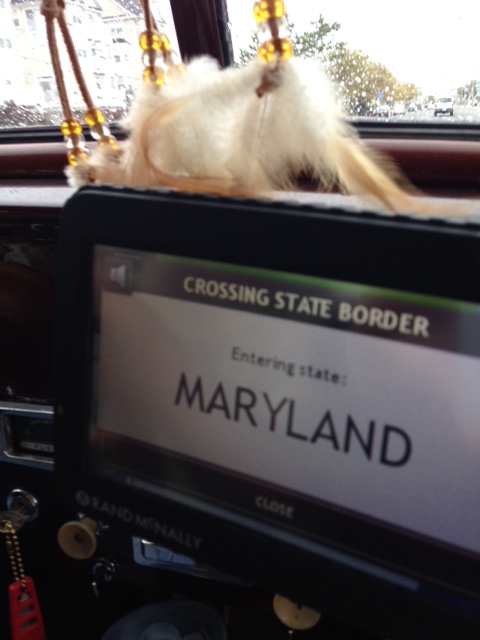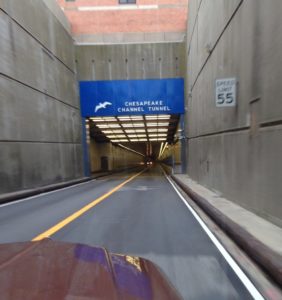Crossing into Maryland
The afternoon of September 24th we made a successful crossing of Delaware Bay on the ferry from Cape May, NJ to Lewes, DE. We then drove south to spend the evening in Ocean City, MD to prepare for our assault on the Chesapeake Bridge-Tunnel on the 25th.
We experienced our first real rain event of the month-long trek during our evening in Ocean City. In case you are not aware, the windshield wipers on the Jeep are little more than a place holder waiting for future design improvement. A) They are small. So small that when it comes time to replace the rubber inserts, I purchase one standard length insert and cut in half to accommodate both sides to the Jeep. B) They do not wipe well. The springs that hold the blades against the windshield are very weak. This was probably designed to limit the drag on the blades as they traverse the windshield due to C) the weak wiper action. The Jeep’s windshield wipers are driven by vacuum from the engine. This method of operation, not unusual for cars of that era, relies on consistent engine vacuum to produce consistent wiper action. Unfortunately, when engine vacuum is low (as for example when attempting to pass a semi-truck spewing torrents of water from its wheels), the wipers come to a stop. Only by lifting one’s foot from the accelerator pedal (not the wisest of moves when passing that truck), can one induce the wipers to provide a swipe or two. The Jeep does have an auxiliary vacuum pump in the form of an adjunct to the fuel pump; however, I have detected little improvement from this feature. One learns to compensate by timing critical maneuvers to coincide with lulls in water flow.
Entering the Chesapeake Bridge-Tunnel, VA
No worries, and the next day after a picnic lunch at Kiptopeke (take that, spell check) State Park, VA, we fueled up the Jeep and made the 20 mile journey along the Chesapeake Bridge- Tunnel across
Chesapeake Bay from Cape Charles, VA to Virginia Beach, VA. It was a little intimidating in that, although we had not had a running problem with the Jeep in the 3,000 miles traveled thus far on this trip, the “NO STOPPING” signs posted on the bridge parts gave one pause to consider the alternatives in case of a problem – over the side??. In addition, the narrow two-lane passages through the two tunnels posted at 55mph were a little scary. First of all, keeping the Jeep in its lane with semi-trucks squeezing by us from the opposite direction at a “bodacious rate of fuel consumption” was more than a little unsettling. Additionally, the grades at the entrances and exits of the tunnels are quite steep, challenging our ability to maintain 55mph (our top and cruising speed) on the exits from the tunnels. In one case, we did get a boost from an oncoming semi- truck whose pressure wave, through some quirk of happenstance, blew us out of the tunnel exit like a performer being shot out of a cannon. Thanks a lot – I think
.
Concrete Ships at Kiptopeke State Park, VA
At Kiptopeke State Park we saw a string of concrete cargo ships setting on the floor of the bay;
presumably acting as breakwaters. I suppose these are of the same type as the one whose remains we saw setting on the beach in Cape May, NJ. Concrete construction of cargo ships was an experiment tried during the World War 1 as an expedient means of making ships. Unfortunately, owing to their heavy weight, they proved impractical and the attempt discontinued. Today, many colleges, including North Carolina State University, participate in intercollegiate concrete canoe competitions. Who was it that said “Those who ignore history are doomed to repeat it” – just joking.
Thursday afternoon on our way to our final evening’s lodging in Edenton, NC, we stopped at the Dismal Swamp State Park in eastern North Carolina. This swamp was first surveyed by George Washington – although due to the bugs, I doubt he slept there. Now much less dismal owing to the draining of the swamp in the 1800’s to facilitate lumbering and farming, it still supports an abundance of flora and fauna typical of semi- swamp environments. We saw lots of interesting ferns and tree formations with contorted root systems to provide stabilization on the congested moist forest floor. The deer are very comfortable with the human intrusion.
Deer at Dismal Swamp State Park, NC
Dismal Swamp Canal
On September 26th, one month to the day from the time we started the North East Trek, we arrived back at our Cary, NC home.





